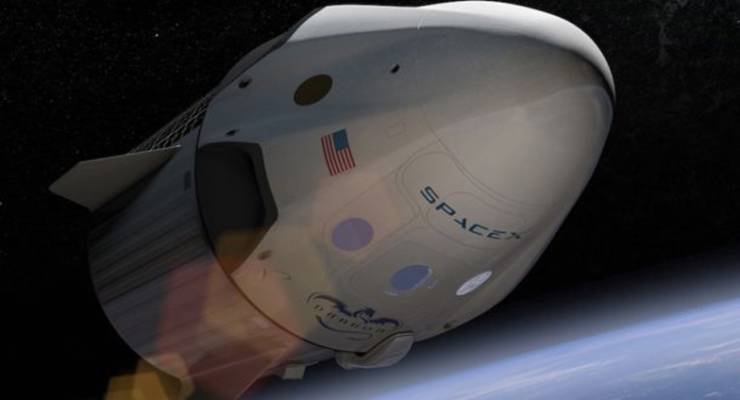
Even SpaceX’s strongest supporters are somewhat surprised by its announcement that it will make its first ever beyond-Earth orbit manned spaceflight in a loop around the Moon next year with two private citizens as paying customers.
SpaceX has yet to fly any passengers into space, or into orbit, although the Dragon spacecraft it will use has recently docked with the International Space Station on an unmanned supply mission and has to date demonstrated itself to be of robust and efficient design.
Before it makes a manned flight to the ISS scheduled for the middle of 2018, the seven-place Dragon will have to be certified by NASA as safe and fit for that mission.
The official announcement of the around-the-Moon joyflight didn’t mention whether or not anyone else would be on board with the two unidentified private passengers.
There are, as commentators have already noted, many aspects of manned space flight that require the meeting of regulatory standards as well as approved courses for space professionals, like those of the American, Russian and European space agencies, and space tourists.
SpaceX’s announcement is thus being regarded in some circles as something of a declaration that space belongs to those who dare, and by grim extension, don’t mind being burned to death in real time on global newscasts, should something go drastically wrong.
SpaceX founder Elon Musk was once famously quoted as saying that 80% of the cost of a NASA rocket launch was spent on administration (or red tape), implying that his enterprise would just go ahead and do things.
Virgin Galactic, which has spent what seems like an eternity this century nudging its sub-orbital rocket rider SpaceShipTwo towards service, appears to have spent considerably more getting it to the point where after one fatal accident, it might be on the verge of flying a full suborbital mission with two test pilots on board.
SpaceX has, despite some launch glitches and one launchpad explosion of its Falcon 9 launcher, proven incredibly innovative in demonstrating a system for successfully landing first stage rockets back on Earth for subsequent reuse.
That shouldn’t be underestimated, even if the timetable for sending two people around the far side of the Moon seems astonishingly brief.
The two wealthy space novices will not be spending five minutes in microgravity in a Virgin Galactic joyflight reaching an altitude of around 110 kilometres. They will be in space for almost a week and as far from Earth as more than 400,000 kilometres at one stage. They will mostly be in zero-G conditions, which sometimes leaves orbital space travelers in the grip of nausea because it can create a sensation of endlessly falling. They will have to cope with fierce G-force loadings on lift off and atmospheric re-entry and handle a few obvious crises that could arise when the craft splashes down on water. Or on land. When Yuri Gagarin made the first manned spaceflight, a single orbit of the Earth, in April 1961 he bailed out at around 7000 metres, landed beside some amazed peasants in rural Russia and used a public phone box to call mission control.
The trajectory proposed for the far side of the Moon flight is similar to that followed by Apollo 13 in April 1970, after it was forced to abandon its original intention to make the third manned landing on the Moon when an explosion damaged its service module.
Is space the place to use paying passengers as flight testers? We may soon find out.
*This article was originally published on Crikey blog Plane Talking








Are we sure that the Moon is Terra Nullius? If not the tourists may be flying over a war zone.
Still, it is good that the private sector contributes to the defense of the planet, even in a sacrificial sense.
“Is space the place to use paying passengers as flight testers?”
It’s a fascinating question, because it goes to the motives for SpaceX making such a high-risk choice. Obviously, paying passengers will help to pay for (part, or all of?) the flight, but that applies to any subsequent flights, against which the test flight costs could be defrayed. To offer the test flight to paying customers seems to be making a very public statement about the value of human life itself; specifically, that (at a certain level of wealth) it’s a private decision. And that idea sends a nasty chill up my spine, because, if you approve of it, you could reasonably ask why should level of wealth forever be the prime consideration? Why not substitute wealth for, say, desperation, and so let poor people ‘choose to be’ life-or-death test subjects?
It would cost at least $300 million for the paying passengers, so only billionaires would be able to afford it.
I can think of a few billionaires I’d like to enjoy the opportunity of leaving this planet, especially if there’s a possibility of them not returning.
In particular, one whose first name is ‘Donald’. And whose surname starts with ‘T’.
I’d even chip in a few dollars in case he’s short. It could be sold to him on the basis that he’d be the first serving president to orbit the Moon.
Can I hike a lift to the moon. Good golf up there. Cheers Bill.
Fly me to the moon. Cheers Bill.